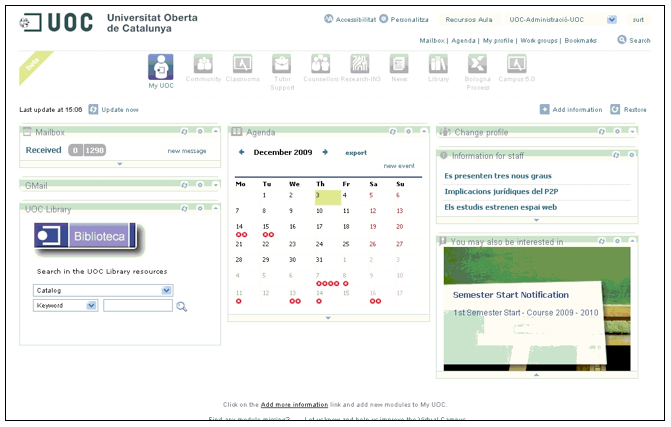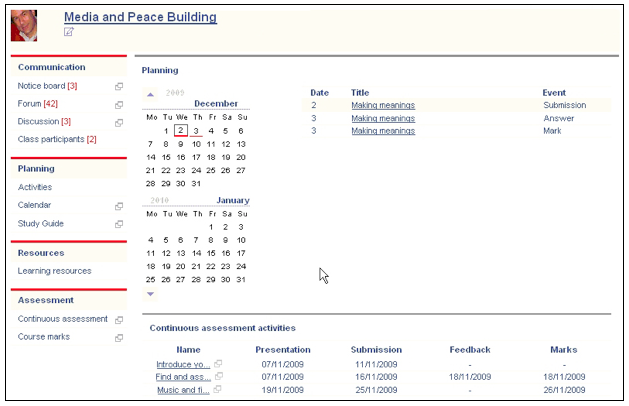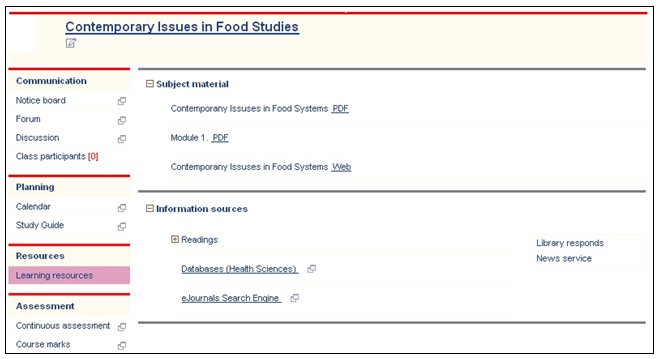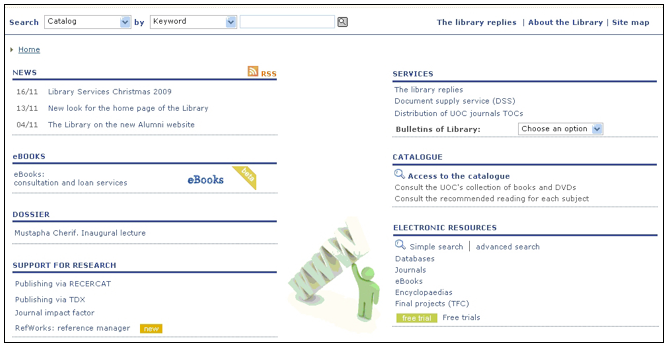D-Lib Magazine
July/August 2010
Volume 16, Number 7/8
Table of Contents
Document Management in the Open University of Catalunya (UOC) Classrooms
Albert Cervera
Universitat Oberta de Catalunya
acervera@uoc.edu
doi:10.1045/july2010-cervera
Printer-friendly Version
Abstract
Through its document management services in Universitat Oberta de Catalunya (Open University of Catalonia, UOC) classrooms, the UOC Library acts as a true learning and teaching facilitator and plays a central role in the university's learning model. Moreover, it serves as a role model for other university libraries in terms of what is expected of them under the new European Higher Education Area (EHEA) framework and the increasing need for them to operate as learning resource centers. Contributing to the library's success is the Virtual Campus, UOC's learning and teaching model that creates a virtual and asynchronous learning environment for students, and allows the UOC's library to be present in all of its classrooms.
Keywords: UOC, Universitat Oberta de Catalunya, university libraries, UOC Library, universities, distance education, e-teaching, e-learning, EHEA, European Higher Education Area, Bologna Process, information management, classroom resources, Virtual Campus, document management.
1. Introduction
One of the objectives of the new European Higher Education Area (EHEA) is to provide people with the necessary knowledge and strategies to engage in continuous, lifelong learning. In the prevailing context at the turn of the century, with new technologies emerging at an ever quicker pace, increasingly less importance is placed on stable, unchanging educational content, whilst the need to teach students to learn, rather than merely transmitting knowledge to them, is viewed as more and more important. In short, the goal is to prepare citizens to engage in continuous learning, which means adopting new teaching models that are quite different from traditional teaching methods based on expository lectures, texts that reiterate the content being taught and a final assessment process.
In this new context, university libraries have an important role to play. It is thus no coincidence that, aware of the opportunity posed by the implementation of the EHEA, Spanish university libraries have been preparing for several years now to become learning and research resource centres (LRRCs). To this end, they have based their efforts on the 'learning resource centre' model used at certain British universities (Serrano-Vicente, 2007; Sunyer, 2006), striving to provide and organise resources for both teaching and research.
In the same vein, and with a view to playing a truly useful role in the learning processes of students, teachers and researchers alike, the UOC Library, as one of the key components of the university's education model, has understood from the start that the best way to facilitate student learning and to provide and organise teaching resources was to ensure that it was present in the university's classrooms, preferably in its own space. From there, it could facilitate access to the information resources selected for each subject as explained below, thereby enhancing the quality and excellence of the learning and teaching processes involved in each subject and programme.
University libraries make genuine efforts to ensure that the resources and services they offer are as useful as possible and that users can take maximum advantage of them. Resource management for classrooms is a complicated field, requiring cooperation between the library and teachers to ensure that the resources are useful for both students and the teacher and not merely a collection of digital resources that happen to touch on some of the same topics as the teaching objectives for each given subject.
The UOC Library's clear orientation towards facilitating learning and teaching, from its origins through to today, is part of its process of ongoing improvement and makes it an outstanding example of what is expected of university libraries under the new EHEA framework and of the increasing need for them to operate as learning resource centres.
The library's document management in UOC classrooms is a crucial part of the process to cease to be 'solely' a learning, teaching and research support tool in order to become a true learning and teaching facilitator, as will be seen in the following sections.
2. The UOC's Virtual Classrooms
2.1. The UOC model: the central role of the Virtual Campus
The UOC was founded in 1994 at the initiative of the Catalan government with a view to offering university-level distance education in Catalan.
One key component of the UOC's teaching and learning model is the Virtual Campus, a virtual environment that allows students to engage in all aspects of the learning process online and asynchronously, that is, at whatever time works best for them (except for the final assessment).
The Virtual Campus is the virtual forum for interaction and communication within the university community and places no limitations on time or space. It includes all the services and resources offered to facilitate the learning process for students.

1. Image of the Virtual Campus homepage.
One of the most salient features of the UOC's Virtual Campus is the fact that it is constantly being updated and adapted to meet the needs of its users, primarily students, in accordance with both their educational requirements and the latest information and communication technologies.
This virtual learning platform, the Virtual Campus, was first developed in 2001. It has since undergone several modifications and upgrades and is currently in version 5.0. The new version (called 'My Campus') features a range of customisable options and settings so that each user can fashion a work space tailored to his or her specific needs. Its architecture, based on free software, enables the integration of learning platform modules, such as Moodle or Sakai, as well as applications, such as Gmail or Facebook. It can, moreover, be accessed from any Internet-enabled device: mobile telephones, PDAs, etc.
Within the framework of the Virtual Campus, the classrooms for the different subjects play an important role. They are the preeminent venues for exchange and learning, the places where and through which teaching is carried out.
2.2. Evolution of the classrooms (background and current model)
Just as the UOC's Virtual Campus has evolved over time both to meet the changing needs of its users and incorporate new technologies and to enhance usability, so have the Virtual Campus's classrooms. They are constantly being adapted to incorporate the latest technological possibilities and, above all, to enhance the user experience for students by becoming more and more accessible, usable, adaptable and customisable, in accordance with each user's preferences and needs.

2. Image of a classroom for the subject 'Media and Peace Building' as seen by the student.
The different redesigns and upgrades that the classrooms have undergone over the years have been led by the university's Office of Learning Technologies and have always been performed in keeping with a development process based on user-focused (students, faculty and management) design methods to ensure that the implemented changes are ultimately successful.
This not withstanding, classroom content has always been grouped into different sections (Communication, Materials, Assessment, etc.), both because that is how the classrooms were originally conceived and because it is what users have preferred in the different user tests conducted for each new modification that has been made to them. The only changes that have been made in this sense with each successive version are the number of sections, how the content is grouped into each section and subsection, and how they are accessed. Likewise, the library has always been present in the classrooms, a fact that has remained unchanged since the original version of the Virtual Campus first went up.
3. The Library in the Classrooms
3.1. Classroom sections
The latest version of the Virtual Campus classrooms divides the content into four main sections: Communication (shared mailboxes); Planning (academic calendar, assessment activities, teaching syllabus); Resources (teaching materials and information sources); and Assessment (mark queries and mailbox for submitting assessable activities).
Some features of the latest version of the virtual classroom can be customised or personalised, both by students and the lecturer in charge of the subject. The goal is to offer students everything they might need at any time during the semester for their learning process, according to the teaching syllabus, in a single virtual space, i.e., the classroom. To this end, students always access the classroom through the Planning section. From there, they can access the content in the other three sections (Communication, Resources and Assessment) with a single click.
When we say that the library is present in all UOC classrooms, we are referring to the resources (information sources, electronic documents and other support tools) and shortcuts to different library services available in the 'Materials and sources' section of the UOC's virtual classrooms.

3. Image of the Materials and sources section of a classroom for the subject 'Contemporary Issues in Food Studies'.
This section contains both the learning materials addressing the specific content of each subject and a selection of links to additional information sources, electronic documents and/or support tools. This latter group primarily consists of electronic documents (articles, chapters, abstracts, etc.), practical activities or exams from previous semesters, specific software for the subject, links to electronic resources and information sources, legal texts, standards and specifications, etc. It is broken down into two different subsections:
Information sources: These are basic electronic resources that allow students to follow and pass the subject. They tend to be electronic documents (articles, chapters, abstracts, study guides, etc.), legal texts or links to resources and information sources.
Support tools: These are supplementary resources and support tools to help students follow the subject. They tend to include special software, manuals, model practical activities and exams from previous semesters, case studies, lists of errata, etc.
The classroom also includes, as an added value for users, a section offering direct access to the UOC Library's newsletter subscription services, which students can use to check the library's themed newsletters and sign up to have a selection of news about a given subject sent directly to their mailboxes with the stated frequency. They moreover include a direct link to the The library replies service for any problems or queries that may arise in relation to the services and content provided in each classroom's 'Materials and sources' section.
3.2. Shared management of classroom resources
Whilst both lecturers and the university library are involved in managing classroom resources, it is the lecturer in charge of the subject who is responsible for choosing the content listed as 'classroom resources' and keeping it up to date. He or she decides which electronic resources must be available in the classrooms for his or her subjects, provides the library with a list thereof and reports any updates and/or modifications to be made to it. This information is sent using an application for reporting problems that was especially developed for this purpose by the university. The Library managers are responsible for ensuring that the resources requested by each lecturer are available in the classroom, performing the necessary searches to find them, offering alternative or supplementary suggestions, where applicable, and ensuring that the system as a whole functions smoothly.
It is worth noting that the resources offered in classrooms for a given subject are automatically copied from one semester to the next, unless the lecturer in charge of the subject notifies the library otherwise.
Separately, the library's information officers also prepare a selection of subject-specific resources from the Digital Library (databases, themed portals, encyclopaedias and dictionaries, e-journal search engines, etc.) for the specific field of knowledge covered by each university degree or programme. Links to these selections of subject-specific digital resources are added to the 'Information sources' section of the classrooms for each degree programme. In short, this selection serves as a gateway to the library, which thus maintains a strong presence in all classrooms, which, in turn, is where students work and interact with their teachers.
Through this presence, the library ensures maximum promotion of its content (in terms of both the services it offers and the different subscription-based and free information sources it contains). Thus, students are able to find everything they need to make the most of their learning experience in a single space (the virtual classroom), whilst the library, through its classroom presence, acts as a true learning facilitator, rather than a mere support service.
3.3. The role of the librarian/information officer in UOC classrooms
Due to its virtual nature and the fact that it is part of a virtual environment, namely, the UOC's Virtual Campus, the UOC Library, through its classroom presence, serves as a permanent gateway to all manner of resources and library services, to the UOC's own and external collections (both physical and digital) and to freely accessible and restricted-access resources available elsewhere online. In short, it is a gateway providing instant, non-stop, round-the-clock access to both the institution's own resources and remote resources in an effort to meet users' needs 'just in case, just in time and just for them'.

4. Image from the UOC library's homepage.
This new library model, which enables uninterrupted access to all resources from different sites and allows users to request any type of service at any time of day, any day of the year, requires a new model of librarian or information officer, too.
First, the new library model requires a professional staff focused on finding, selecting and organising information, tutoring users and, above all, offering continuous training on the use of new information technologies and resources, so that the users will not be prevented from using information by any technological barriers.
Second, as a library that can be accessed from different sites and is present in all Campus classrooms, its librarians/information officers must work closely with the university faculty to meet the different user needs, in accordance with the specific requirements of each degree programme, field of knowledge, subject, etc.
3.5. Copyright management
The resources and software included in classroom sections as support tools or information intended to supplement the materials for a given subject may sometimes require copyright permission for use in the Campus classrooms. This is generally the case with book chapters, articles and certain specific software.
In these cases, the lecturer requesting this material for his or her classrooms must contact the people responsible for copyright management at the university by means of an online form, where he or she specifies the document's full details, the period of time for which it will be needed, the subjects for which it must be available, etc. Once the relevant copyright permission has been processed, it is forwarded to the library, which then makes the documents available to the students in the relevant classrooms. However, the electronic document is first protected to ensure that no undue use is made of it, and a range of metadata is included to make it easily identifiable and retrievable.
The joint work carried out by the UOC Library and the people responsible for copyright management at the university goes beyond merely processing copyright permissions for the electronic documents (book chapters, articles, etc.) offered to students in Virtual Campus classrooms. Each semester, permissions are checked for expiry and the lecturers in charge are notified far enough in advance to request that they be extended, where necessary.
The library, in conjunction with the people responsible for copyright management at the UOC, keeps all the electronic documents that have ever been used as classroom resources on file, whether or not the permissions are still valid, so as to conserve and, where applicable, reuse them in future.
4. Conclusions
The document management services performed by the UOC Library in the university's classrooms are a critical component of the library's presence in Virtual Campus classrooms. Together with the links provided to the digital collection and the shortcuts to recommended references for each subject, these services ensure that the library acts as a learning facilitator, providing and organising the necessary resources for teaching in the classrooms in its own space and affording students access to all the information resources chosen for each subject.
These services require a collaborative effort between librarians/information officers and faculty members, so as to meet different user needs in accordance with each degree programme, field of knowledge, subject, etc., as well as between librarians/information officers and those responsible for copyright management at the university, in order to ensure that proper use is made of the different resources selected for each Virtual Campus classroom.
Such joint efforts lead to mutual enrichment and, above all, afford the library a strong presence in the classrooms, where it acts as a genuine learning facilitator for students, not only through its management of the electronic documents made available, but also by serving as a gateway to the other digital resources offered to students and teachers in each case.
In this sense, the UOC Library is an excellent example of what is expected of university libraries under the new EHEA framework, namely, that they become centres that choose, provide and organise teaching and research resources in accordance with their users' needs. In other words, that they act as learning facilitators. The UOC's system, in particular, offers an added value: it does all this in the very space where the teaching-learning process is carried out, i.e., in the Virtual Campus classroom.
References
Balagué, Núria (2003). 'La Biblioteca Universitaria, centro de recursos para el aprendizaje y la investigación: una aproximación al estado de la cuestión en España'. Jornadas Rebiun 2003: Los centros para recursos del aprendizaje y la investigación en los procesos de innovación docente. Palma de Mallorca, May 2003. http://www.rebiun.org/opencms/opencms/handle404?exporturi=/export/docReb/ponencia_balague_mola.pdf&. [Accessed: 14/09/2009.]
Caridad, Mercedes et al. (2005). 'La Biblioteca Universitària com a centre de recursos per a l'aprenentage i la investigació'. Item, vol. 40, p. 87-108.
Domínguez, María Isabel (2005). 'La biblioteca universitaria ante el nuevo modelo de aprendizaje: docentes y bibliotecarios, aprendamos juntos porque trabajamos juntos'. RED. Revista de Educación a Distancia, Monograph No. II. http://www.um.es/ead/red/M4/dominguez9.pdf. [Accessed: 04/09/2009.]
Gijón, J.; López, A.; Gálvez, C.; Caro, C. 'La biblioteca universitaria como apoyo al aprendizaje en el Espacio Europeo de Enseñanza Superior'. Encontros Bibli: Revista Eletrônica de Biblioteconomia e Ciência da Informação, América do Sul, 11 13 12 2007.
http://www.periodicos.ufsc.br/index.php/eb/article/view/364/428. [Accessed: 01/09/2009.]
Martínez, Dídac (2004). 'El Centro de Recursos para el Aprendizaje CRAI. El nuevo modelo de biblioteca universitaria'. Educación y biblioteca, vol. 16, No. 144, p. 98-108.
http://www.aab.es/pdfs/gtbu_crai.pdf. [Accessed: 25/09/2009.]
Pérez, Dora; Torn, Pep (2009). "M-Library in an m-University: Changing Models in the Open University of Catalonia" in Second International m-libraries Conference. http://ocs.sfu.ca/m-libraries/index.php/mlib/mlib2009/. [Accessed: 27/09/2009.]
Plan estratégico de REBIUN (2003-2006). http://www.rebiun.org/opencms/opencms/handle404?exporturi=/export/sites/Rebiun/doc/plan_estrategico.pdf&%5d. [Accessed: 04/09/2009.]
Rovira, Anna (2007). 'Les biblioteques universitàries i el suport a la recerca'. BiD: textos universitaris de biblioteconomia i documentació, No. 18 (June). http://www2.ub.edu/bid/consulta_articulos.php?fichero=18rovir1.htm. [Accessed: 07/07/2010.]
Serrano-Vicente, Rocío (2007). 'Los Learning Centres en el Reino Unido. Estudio de caso de seis universidades medianas'. El profesional de la información, July-August, vol. 14, No. 4, p. 307-318.
Sunyer, Sílvia (2006). 'Centros de recursos para el aprendizaje y la investigación — CRAI —, y servicios bibliotecarios estratégicos para una Europa basada en el conocimiento'. Intangible Capital, vol. 2, No. 14, p. 327-337.
About the Author
 |
Albert Cervera (1968, Barcelona, Spain) has a degree in Spanish literature and linguistics from the University of Barcelona and a degree in Documentation from the Universitat Oberta de Catalunya (Open University of Catalonia, UOC). He currently works in the UOC Library's Documentary Resources department, where he is in charge of the classrooms' digital contents.
|
|